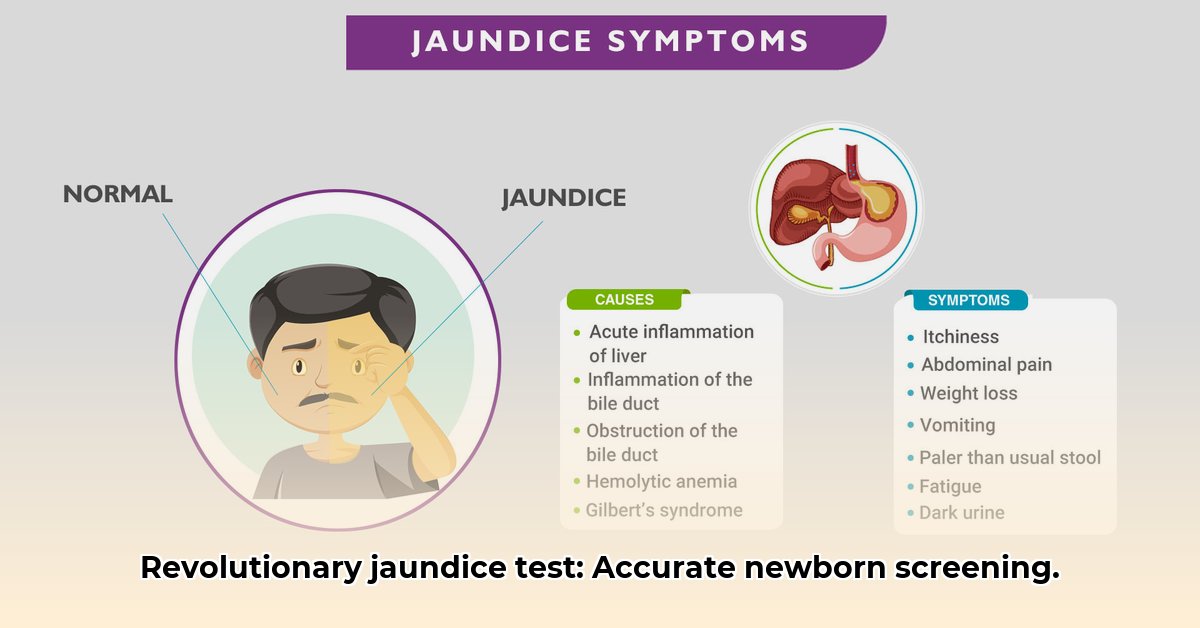Newborn jaundice is a prevalent condition demanding timely and accurate detection. Transcutaneous Bilirubinometry (TcB) offers a non-invasive solution for measuring bilirubin levels, eliminating the need for needles. This article investigates TcB, examining its advantages, limitations, and role in newborn jaundice screening. For more information on jaundice screening, see this helpful resource.
Understanding Transcutaneous Bilirubinometry (TcB) for Early Jaundice Detection
Transcutaneous bilirubinometry (TcB) provides a swift and painless method to assess bilirubin levels in newborns without invasive blood draws. This approach offers reassurance to parents and facilitates prompt intervention, proving particularly valuable in settings where blood testing resources are scarce. The technology employs a handheld device that emits light onto the baby’s skin, analyzing the reflected light to determine bilirubin concentration, providing instant results.
Key advantages of TcB:
- Offers a painless, needle-free alternative to traditional blood tests.
- Provides immediate results, accelerating diagnosis and treatment initiation.
- Particularly beneficial in regions with limited access to laboratory facilities and blood testing.
Accuracy and Limitations of TcB in Newborns
While TcB serves as an effective screening tool for identifying newborns unlikely to have hyperbilirubinemia, its accuracy in detecting elevated bilirubin levels can vary. A follow-up blood test, known as a serum bilirubin test, is often necessary to confirm high TcB readings. Several factors influence TcB accuracy, including skin pigmentation, gestational age, and variations among different TcB devices. Healthcare providers must adhere to standardized procedures to ensure reliable results.
To improve reliability and consistency, universal guidelines for interpreting TcB results are essential, enabling standardized assessments and improving overall care for newborns.
Factors Influencing TcB Readings
- Skin Tone: Pigmentation can affect how light is absorbed and reflected, impacting the accuracy of TcB readings.
- Gestational Age: Premature infants may have different bilirubin metabolism rates, influencing TcB accuracy.
- Device Type: Variations in technology and calibration among TcB devices can lead to discrepancies in measurements.
Cost-Effectiveness and Global Accessibility of TcB
TcB has the potential to reduce healthcare costs by decreasing the reliance on blood tests. However, the necessity for confirmatory serum bilirubin tests can impact overall cost savings. Access to TcB technology remains limited in many lower-income countries, hindering comprehensive data collection and emphasizing the need for strategies aimed at global implementation and equitable resource allocation.
Advantages and Disadvantages of TcB
Advantages:
- Non-invasive and painless procedure, reducing discomfort for newborns.
- Provides rapid results, enabling immediate clinical decisions.
- Potentially reduces healthcare costs by minimizing the need for blood tests.
Disadvantages:
- May require confirmatory blood tests to verify elevated readings.
- Accuracy can be influenced by skin tone, gestational age, and device-specific factors.
- Uneven global distribution limits accessibility in resource-constrained regions.
Innovations in TcB Technology and Research
Ongoing research efforts focus on enhancing TcB accuracy, integrating TcB results with other clinical data, and developing predictive models for improved jaundice risk assessment. These continuous advancements in technology and data analytics promise more reliable and accessible newborn jaundice screening in the future.
Improving TcB Accuracy in Low-Resource Settings
Neonatal jaundice is a significant global health concern, particularly in low-resource settings. Addressing this issue necessitates strategies to enhance TcB accuracy, such as incorporating artificial intelligence (AI) algorithms calibrated for diverse skin tones and ensuring access to reliable, user-friendly devices.
Enhancing TcB Accuracy with AI and Comprehensive Training
To enhance TcB accuracy in low-resource settings, several practical steps can be implemented:
- Invest in robust, user-friendly TcB devices that are easy to maintain and calibrate.
- Develop AI algorithms trained on diverse datasets to account for variations in skin pigmentation and improve measurement accuracy across different ethnicities.
- Provide comprehensive training programs for healthcare workers to ensure proper device operation, standardized measurement techniques, and accurate interpretation of results.
- Promote community awareness and education to encourage early detection and timely medical intervention.
Impact of TcB Screening on Hospital Readmissions
TcB screening has the potential to reduce hospital readmissions for jaundice by facilitating early detection and treatment. However, it might also lead to an increase in phototherapy usage as a precautionary measure. Further research is essential to determine the optimal strategies for implementing TcB effectively in various healthcare settings and to evaluate its long-term impact on neonatal outcomes.
Implementing TcB in Resource-Constrained Neonatal Units
Successfully implementing TcB in neonatal units with limited resources requires addressing challenges related to equipment costs, training requirements, and logistical considerations. Cost-effective strategies for introducing TcB may include establishing partnerships with non-profit organizations, leveraging telemedicine for remote consultations, and prioritizing training for key healthcare personnel.
Reducing Parental Anxiety with TcB
TcB offers a less invasive alternative to blood tests, which can significantly reduce parental anxiety during newborn jaundice screening. However, it is crucial to educate parents about the limitations of TcB and the potential need for confirmatory blood tests. Clear communication and empathetic support can help alleviate parental concerns and ensure informed decision-making.
Smartphone-based applications for jaundice screening hold promise for increasing TcB accessibility, but further research is needed to validate their accuracy and reliability in diverse populations.
- Water Wheel Electric Generator Provides Free Home Electricity - December 15, 2025
- Choosing the Right Portable Hydro Turbine for Your Needs - December 14, 2025
- Best Portable Hydro Generators for Off-Grid and Outdoor Power - December 13, 2025
















